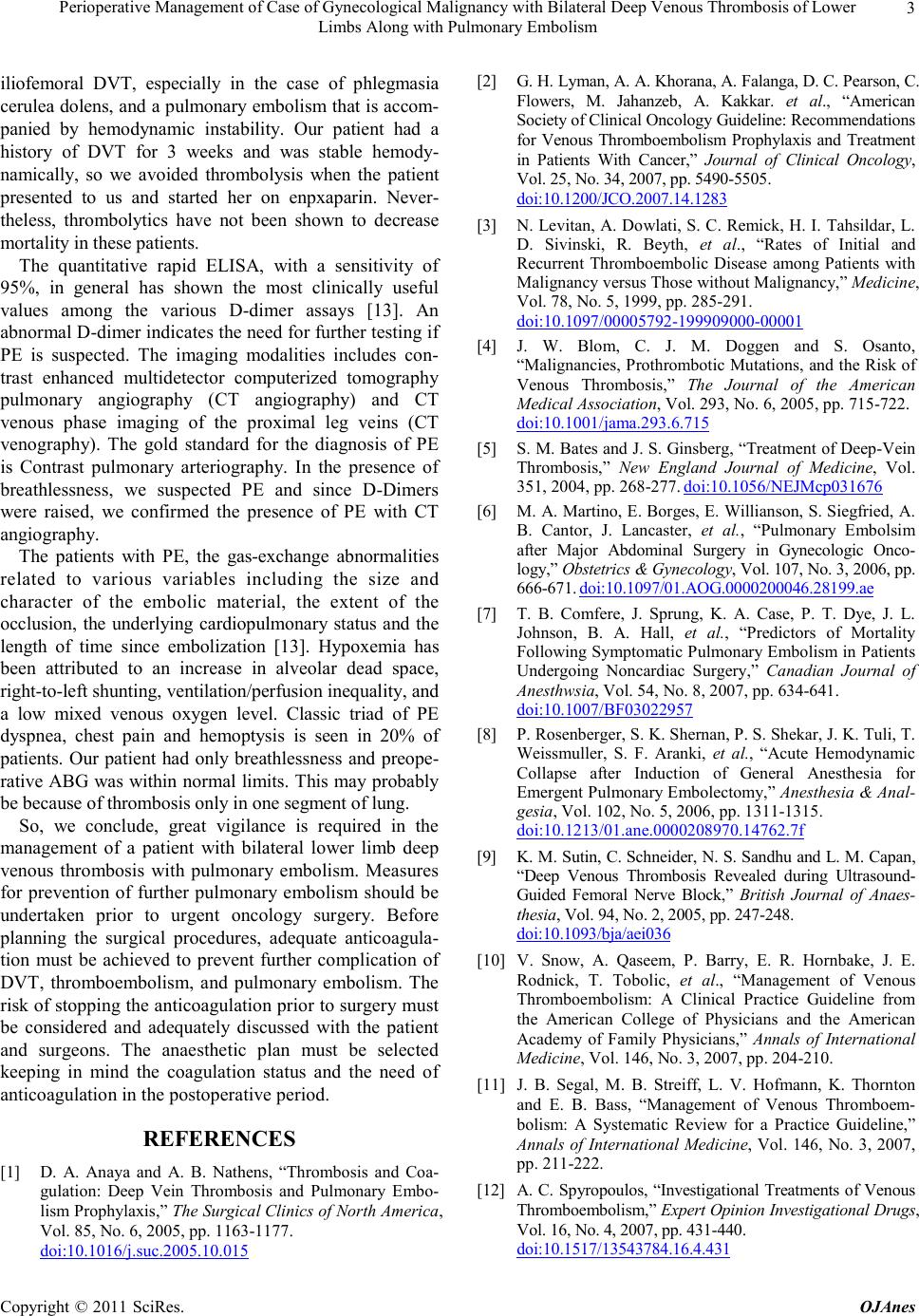
Perioperative Management of Case of Gynecological Malignancy with Bilateral Deep Venous Thrombosis of Lower 3
Limbs Along with Pulmonary Embolism
iliofemoral DVT, especially in the case of phlegmasia
cerulea dolens, and a pulmonary embolism that is accom-
panied by hemodynamic instability. Our patient had a
history of DVT for 3 weeks and was stable hemody-
namically, so we avoided thrombolysis when the patient
presented to us and started her on enpxaparin. Never-
theless, thrombolytics have not been shown to decrease
mor t a l i t y in t hese pat ients.
The quantitative rapid ELISA, with a sensitivity of
95%, in general has shown the most clinically useful
values among the various D-dimer assays [13]. An
abnormal D-dimer indicates the need for further testing if
PE is suspected. The imaging modalities includes con-
trast enhanced multidetector computerized tomography
pulmonary angiography (CT angiography) and CT
venous phase imaging of the proximal leg veins (CT
venography). The gold standard for the diagnosis of PE
is Contrast pulmonary arteriography. In the presence of
breathlessness, we suspected PE and since D-Dimers
were raised, we confirmed the presence of PE with CT
angiography.
The patients with PE, the gas-exchange abnormalities
related to various variables including the size and
character of the embolic material, the extent of the
occlusion, the underlying cardiopulmonary status and the
length of time since embolization [13]. Hypoxemia has
been attributed to an increase in alveolar dead space,
right-to-left shunting, ventilation/perfusion inequality, and
a low mixed venous oxygen level. Classic triad of PE
dyspnea, chest pain and hemoptysis is seen in 20% of
patients. Our patient had only breathlessness and preope-
rative ABG was within normal limits. This may probably
be because of thromb osis only in one segment of l ung.
So, we conclude, great vigilance is required in the
management of a patient with bilateral lower limb deep
venous thrombosis with pulmonary embolism. Measures
for prevention of further pulmonary embolism should be
undertaken prior to urgent oncology surgery. Before
planning the surgical procedures, adequate anticoagula-
tion must be achieved to prevent further complication of
DVT, thromboembolism, and pulmonary embolism. The
risk of stopping the anticoagulation prior to surgery must
be considered and adequately discussed with the patient
and surgeons. The anaesthetic plan must be selected
keeping in mind the coagulation status and the need of
anticoagulation in the postoperative period.
REFERENCES
[1] D. A. Anaya and A. B. Nathens, “Thrombosis and Coa-
gulation: Deep Vein Thrombosis and Pulmonary Embo-
lism Prophylaxis,” The Surgical Clinics of North America,
Vol. 85, No. 6, 2005, pp. 1163-1177.
doi:10.1016/j.suc.2005.10.015
[2] G. H. Lyman, A. A. Khorana, A. Falanga, D. C. Pearson, C.
Flowers, M. Jahanzeb, A. Kakkar. et al., “American
Society of Clinical Oncology Gui deline: Recommendati ons
for Venous Thromboembolism Prophylaxis and Treatment
in Patients With Cancer,” Journal of Clinical Oncology,
Vol. 25, No. 3 4, 2 007, pp. 5490-5505.
doi:10.1200/JCO.2007.14.1283
[3] N. Levitan, A. Dowlati, S. C. Remick, H. I. Tahsildar, L.
D. Sivinski, R. Beyth, et al., “Rates of Initial and
Recurrent Thromboembolic Disease among Patients with
Malignancy versus Those without Malignancy,” Medicine,
Vol. 78, No. 5, 1999, pp. 285-291.
do i:10. 1097/00005792 -199909000 -00001
[4] J. W. Blom, C. J. M. Doggen and S. Osanto,
“Malignancies, Prothrombotic Mutations, and the Risk of
Venous Thrombosis,” The Journal of the American
Medical Association, Vol. 293, No. 6, 2005, pp. 715-722.
doi:10.1001/jama.293.6.715
[5] S. M. Bates and J. S. Ginsberg, “Treatment of Deep-Vein
Thrombosis,” New England Journal of Medicine, Vol.
351, 2004, pp. 268-277. doi:10.1056/NEJMcp031676
[6] M. A. Martino, E. Borges, E. Willianson, S. Siegfried, A.
B. Cantor, J. Lancaster, et al., “Pulmonary Embolsim
after Major Abdominal Surgery in Gynecologic Onco-
logy,” Obstetri cs & Gyneco logy, Vol. 107, No. 3, 2006, pp.
666-671. doi:10.1097/01.AOG.0000200046.28199.ae
[7] T. B. Comfere, J. Sprung, K. A. Case, P. T. Dye, J. L.
Johnson, B. A. Hall, et al., “Predictors of Mortality
Following Symptomatic Pulmonary Embolism in Patients
Undergoing Noncardiac Surgery,” Canadian Journal of
Anesthwsia, Vol. 54, No. 8, 2007, pp. 634-641.
doi:10.1007/BF03022957
[8] P. Rosenberger, S. K. Shernan, P. S. Shekar, J. K. Tuli, T.
Weissmuller, S. F. Aranki, et al., “Acute Hemodynamic
Collapse after Induction of General Anesthesia for
Emergent Pulmonary Embolectomy,” Anesth esia & Anal-
gesia, V ol. 10 2, No . 5, 200 6, pp. 1311-1315.
doi:10.1213/01.ane.0000208970.14762.7f
[9] K. M. Sutin, C. Schneider, N. S. Sandhu and L. M. Capan,
“Deep Venous Thrombosis Revealed during Ultrasound-
Guided Femoral Nerve Block,” British Journal of Anaes-
thesia, Vol. 94, No. 2 , 2005, pp. 2 47-24 8.
doi:10.1093/bja/aei036
[10] V. Snow, A. Qaseem, P. Barry, E. R. Hornbake, J. E.
Rodnick, T. Tobolic, et al., “Management of Venous
Thromboembolism: A Clinical Practice Guideline from
the American College of Physicians and the American
Academy of Family Physicians,” Annals of International
Medicine, Vol. 146, N o. 3, 20 07, pp. 204-210.
[11] J. B. Segal, M. B. Streiff, L. V. Hofmann, K. Thornton
and E. B. Bass, “Management of Venous Thromboem-
bolism: A Systematic Review for a Practice Guideline,”
Annals of International Medicine, Vol. 146, No. 3, 2007,
pp. 211-222.
[12] A. C. Spyropoulos, “Investigational Treatments of Venous
Throm boembolism,” Expert Opinion Investigational Drugs,
Vol. 16, No. 4 , 20 07, p p. 4 31- 44 0.
doi:10.1517/13543784.16.4.431
Copyright © 2011 SciRes. OJAnes